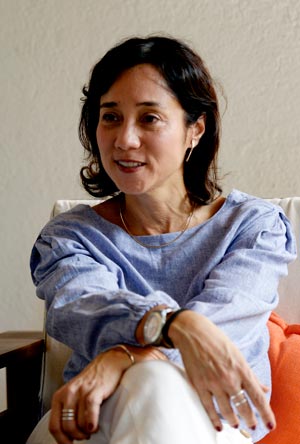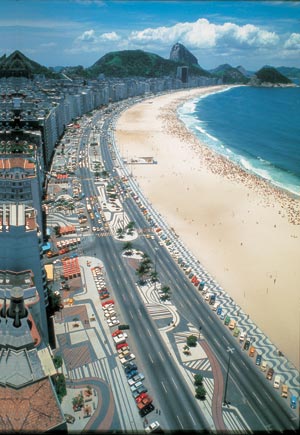Keeping a legacy alive

Isabela Ono: At Bawa's De Saram House last week. Pic by Indika Handuwala
When Isabela Ono was a little girl, and her friends would ask what her father did, she would say he designed gardens and they would say “oh so he’s a gardener”. There was no word in Portuguese for ‘paysagiste’ or landscape designer which is what her architect father’s work actually was and she had no inkling of how well known he was either until he came with Roberto Burle Marx to the opening of a public square close to her school.
Roberto Burle Marx was Brazil’s internationally famous modernist landscape designer and Isabela’s father Haryushi Ono, his longtime partner and close friend. It was only when she saw the fuss around their presence at that small ceremony that the realization dawned.
Landscape gardening is in her DNA, smiles Isabel, the ideas, concepts, she practises all unconsciously absorbed through decades of working closely with them and so it is perfectly fitting that when she delivered yesterday’s Geoffrey Bawa memorial lecture (the 20th), it was not in the sterile confines of a conference hall but in the mellow setting of Bawa’s most beloved garden – Lunuganga.
Isabela is herself an architect with a masters in urban design and today, has dedicated herself to keeping the legacy of Burle Marx alive. Her childhood memories are all of growing up around gardens, dropping in on the studio where the two partners were engrossed in design and going over the weekends to Burle Marx’s extensive estate – house and garden, the Sitio Roberto Burle Marx where his large laboratory also housed thousands of Brazil’s indigenous plants. This he was to donate to the Brazilian government.
Born in São Paulo, Roberto Burle Marx was not an architect, but rather an artist who curiously enough became fascinated with plants when he chanced upon a collection from his home country at the Botanical Garden in Berlin while in Germany as a young man. Returning to Rio de Janeiro, he graduated in fine arts and began exploring Brazil’s rich and diverse biomes, from the coastal forest (Mata Atlantica), the Amazon and the Cerrado, the arid savanna and bringing back native ornamental plants to his home laboratory to grow. Early in his career, he also worked with celebrated Brazilian architects like Oscar Niemeyer and whilst a painter and sculptor, was also a textile and jewellery designer and ceramicist.
In his 60 years of work, Burle Marx designed many spectacular private gardens for clients and businesses but he preferred the public spaces. Democratic spaces, as Isabela puts it, were most important to him. His studio was opened in 1955 and it was in 1965, that Haryushi Ono, then still an architectural student went to work with him. Three years later as Ono graduated, he was made a partner and in their nearly 30-year association, he worked on some of Burle Marx’s most distinctive and acclaimed landscape projects – among them the stunning 5 km mosaic walkway designed with undulating geometric waves that stretches the length of Copacabana’s beachfront and Flamengo Park, considered one of his most beautiful creations. Both these, Isabela says, are works in progress that they both kept a close eye on, throughout their lives.

Long association: Roberto Burle Marx and Haryushi Ono. Pic by Rafael Adorjan
The multi-faceted Burle Marx was also a visionary ecological activist whose campaign against the then military regime’s destructive plans for the deforestation of the Amazon rainforest had a vital impact in raising awareness for conservation at a time when few considered it. They had practised sustainability in their landscape projects all along, Isabela says quizzically, long before the word became common parlance.
When Burle Marx died in 1994, he left his practice to Ono who continued his work, Isabela joining him in the sudio as a student.
This is Isabela’s first trip this far East but interestingly she recalls that Burle Marx and her father had built a city centre in the Malaysian capital and her father even came back to Kuala Lumpur to check on it shortly before he died.
On her father’s death in 2017, left with a wealth of historical documents, plans and drawings from the studio of Burle Marx, Isabela realised she had an enormous responsibility: to preserve this legacy.
So in 2018 was born the Instituto Burle Marx which today holds this precious collection of records of more than 2000 projects. Faced with a growing demand from architects, researchers and students to peruse Burle Marx’s works, Isabela, now Executive Director of the Institute says that she and her partners – her brother Julio Ono and Gustavo Leivas, found that there was a need for proper archives to preserve the documents, drawings and records, some in fragile condition for posterity. “It was not for me, it was not about money. It was about history, it was about legacy.”

A modern classic: Roberto Burle Marx's Copacabana sidewalk. (Credit: Haryushi Ono). Pix courtesy Burle Marx collection
But she had little idea of how to start a non-profit organisation as the archive is. They nevertheless took the plunge “with no funds, with no resources’ and have since found support and encouragement from many quarters. In June 2019, the New York Botanical Garden invited Isabela to talk at a symposium they were holding along with the grand exhibition of Burle Marx titled ‘Brazilian Modern: The Living Art of Roberto Burle Marx’, and there followed a two year grant from the Leon Levy Foundation in New York. They are now also part of a wider knowledge sharing network with MOMA, the New York Metropolitan Library and other institutions
The archive is still on the first floor of their studio but Isabela is optimistic of the future and the opportunities to make his work known more. So when chief curator of the Bawa Trust in a faraway tropical island, Shayari de Silva invited her to give the Bawa memorial lecture, she was delighted to accept. They have discovered much common ground in Burle Marx and Bawa’s passion for nature, their inter-disciplinary approach and Shayari also reflects on the many public spaces that Bawa too created though they are little remembered now.
Isabela’s lecture on the legacy of Burle Marx was just one part of the celebration of Lunuganga’s 75th year; also planned for later this year is another talk in the ‘On Gardens’ series to be followed by an installation of works from Bawa, Burle Marx and the celebrated Japanese-American sculptor Isamu Noguchi. The prospective collaboration between the institutions dedicated to keeping alive the legacy of these three visionaries is something that both Isabela and Shayari find most heartening.
Burle Marx was completely Brazilian and his life’s work was for the Brazilian people, Isabela says. That and her own very personal connection to the great man inspires and drives her work with the Institute: to bring his thought and vision to present and future generations to move towards greener, more inclusive cities.
Searching for an ideal partner? Find your soul mate on Hitad.lk, Sri Lanka's favourite marriage proposals page. With Hitad.lk matrimonial advertisements you have access to thousands of ads from potential suitors who are looking for someone just like you.


